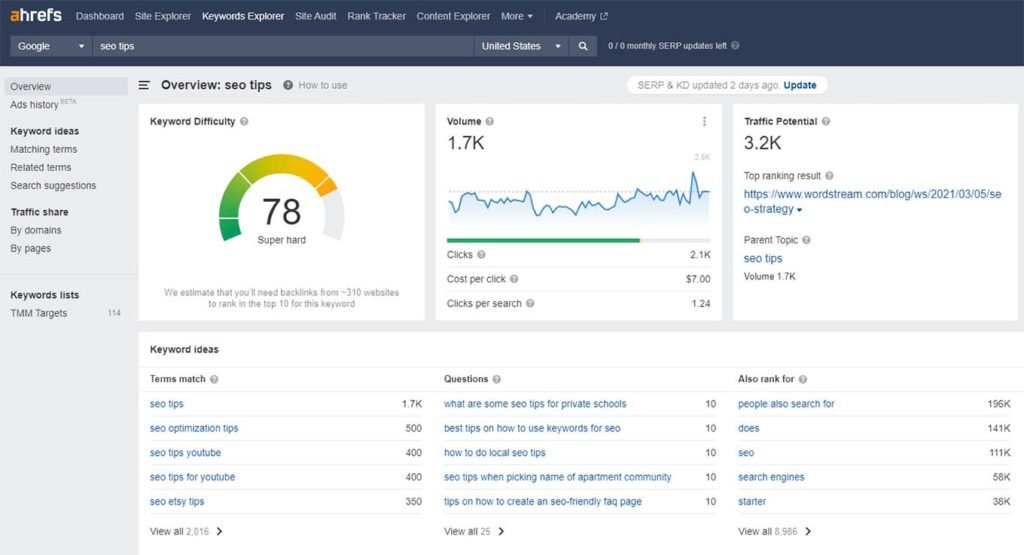Whether you’re running a business or launching a side hustle, you know that generating leads is essential to your success. But unlike other forms of digital marketing, SEO lead generation can be confusing and intimidating.
SEO strategy involves keyword research, formulating a content strategy, understanding search intent, link building, and more. Is all of that complexity really worth the trouble? If you want to generate leads and grow your business, the short answer is yes.
In this article, we’ll cover how to reach your target audience with Google search and then convert your website traffic into qualified leads. Let’s dive into the marketing strategy of SEO lead generation!
What Is SEO Lead Generation?
SEO, or search engine optimization, is the process of improving the visibility and ranking of a website or web page in search engine results pages (SERPs). Onsite, offsite, and technical SEO techniques are used to bring organic traffic to a site from search engines like Google and Bing.
SEO lead generation takes this process a step further by utilizing SEO to generate not just website visitors, but business leads. These prospects can then be potentially converted into customers and clients.
How Does SEO Fit Into My Lead Generation Strategy?
Successful businesses tend to diversify their lead generation efforts in order to avoid an over-reliance on any one platform. Compared to other digital marketing approaches, SEO is one of the most stable and profitable options. However, it requires a combination of skill, commitment, and patience to see results. For this reason, SEO is often not the first step for a new business.
PPC, or pay-per-click, advertising offers a more expensive but much faster feedback cycle. After launching an ad on Facebook or Google, the advertiser can see results and implement changes in a matter of days, not months. When learning how to make money online as a beginner, PPC is a great way to answer questions like “Who is my ideal customer” and “What pain points does my product/service solve”. Quickly testing different offers, target audiences, landing pages, and more helps businesses to hone in on their marketing efforts.
After finding product-market fit, SEO can round out an effective lead generation strategy. Because PPC is volatile but can scale aggressively, think of it as a way to raise the ceiling of business performance. SEO, on the other hand, is a slow and steady growth strategy that can be thought of as raising the floor for business performance.
How To Leverage SEO Lead Generation
To use SEO for lead generation, first launch an effective SEO campaign. Once you manage to bring steady organic traffic to your website, then shift your attention to capturing leads and connecting your SEO leads to the sales funnel for your product or service. For a step-by-step guide on how to implement SEO lead generation, follow the 3 step process below.
1) Nail Your SEO Strategy

Identify Your Target Audience
Before performing keyword research, it is important to reflect on your target audience. Consider what problems your products or services solve, and what topics a potential customer may be researching on Google.
From informational “how to” searches to transactional “best ___” searches, you will need to create content on your website that addresses each concept. Ultimately, to drive more organic traffic these blog posts will need to satisfy the true search intent of the keyword. To do this, you must have a deep understanding of your customers’ needs and desires.
Research Relevant Keywords
Keyword research is a critical component of making sure your website content gets served to potential customers. Because searchers generally only view the first page of search results, striking the right balance of search volume and difficulty is key.

For example, if you write a post targeting the keyword ‘SEO Tips’ which Ahrefs ranks as “Super hard” to rank for, you will likely never reach the first page of Google. That means even if you write the best possible content on the topic, you are unlikely to generate leads from the article. Reflexively, some marketing teams allocate their SEO efforts to writing content about longtail keywords, or terms that are highly specific (and usually have low search volume). However, this can also result in a blog full of articles that almost no one is reading.
The ideal solution is to find relevant keywords that have a medium search volume and are not too competitive. The best way to do this is to use a keyword research tool like Ahrefs, Google Keyword Planner, or Semrush.
Create A Content Strategy
After identifying a list of keywords, the next step is creating an SEO content strategy. This includes mapping out the topics you will cover, blog post frequency, target word count, and more. Initially, try to group your keywords into content clusters around 2-3 broad topics. This approach will allow you to link internally between articles, which can help your website rank as you develop authority in the eyes of search engines.
A content strategy also needs to consider the buyer’s journey. If you are an auto parts company, for example, a potential customer who is in the awareness stage will likely be researching general keywords like “car won’t start”. However, a customer in the decision stage will be searching for something much more specific, like “buy car battery near me”.
While building a content strategy, consider which stage of the buyer’s journey your potential customers are in and adjust your keyword targets accordingly. Over time strive to target a mix of both general and specific keywords to reach customers at all stages of the journey. As your content is indexed by search engines, your web pages will begin to rank higher on search engine results pages. At this stage, you can allocate a portion of your SEO efforts to increasing the domain rating of your website.
Build Domain Authority
Domain authority is a metric that predicts how well a website will rank on search engines. The higher your domain authority, the more likely your web pages are to appear near the top of search results. To build domain authority, focus on two main SEO tactics:
1. Create backlinks
To increase the number of backlinks to your website, start by conducting a review of all the websites and social media platforms you control. Make sure each site includes a link back to your website.

After tackling the low-hanging fruit, reach out to other websites in your niche and offer to write them a guest post. Inside your post include a link to further resources on your own website. You can also source backlinks from HARO. By providing quotes and insights to reporters you can occasionally land a link on highly influential news sites.
Lastly, search for broken links on websites in your industry. If you find any, reach out to the website owner and let them know. Many times they will be happy to update the link to include your website instead.
2. Write high-quality content
Google’s mission is to “organize the world’s information and make it universally accessible and useful”. For your website to rank, you need to show Google that your content is useful. Write blog posts, create infographics, and make videos that answer questions your target audience is searching for. Go above and beyond to make sure your content is the best answer to a searcher’s question.
Not only will this improve your chances of ranking, but it will also attract organic links from other websites that write on similar topics. As other websites link to your resources, you will build credibility, traffic, and lead-generation opportunities.
2) Direct Lead Generation
Once you have applied your SEO strategy and built a steady stream of traffic to your site, convert your website visitors into leads for your business. Begin by installing a lead capture form on your website. This can be as simple as a pop-up, a newsletter signup in the footer, or an email capture form that appears when someone clicks on a specific call-to-action.

Your lead capture form should be short, sweet, and to the point. The goal is to collect enough information to help you qualify the lead without being intrusive. To incentivize visitors to submit their information, consider offering something in return. This approach is known as a lead magnet and can take many forms.
Some common lead magnets include eBooks, white papers, templates, checklists, how-to guides, and free trials. By providing value to these potential customers upfront, you can greatly increase the form’s conversion rate and amplify your SEO lead generation efforts.
Make sure these SEO leads are routed directly to an automated email marketing flow or a salesperson. After all of your search engine optimization work, it’s important to monetize your leads and enjoy the return on your investment.
3) Indirect Lead Generation
While SEO lead generation typically takes place directly on your website or landing pages, there are other digital channels where you can simultaneously increase brand awareness and attract new leads. In fact, your content marketing efforts from SEO lead generation will likely build your authority and reputation in your niche. Leverage this newfound influence to generate additional leads through social media, webinars, and trade shows.
As you create content, share it on social media platforms, in forums, and with other businesses in your industry. This will help you amplify your reach, attract new links, and generate leads from sources outside your website and Google organic search.

Webinars are another great way to showcase your industry expertise and attract new leads. Revisit the content you created for SEO lead generation and dive deeper into best practices, your products or services, or other salient topics. You can also invite guest speakers, collaborate with other businesses, or run a Q&A session to further engage your audience.
Finally, don’t forget about offline lead generation opportunities. Attend trade shows and meetups in your industry to network with potential customers face-to-face. You can also sponsor these events to increase brand awareness and attract new leads. No matter what indirect lead generation strategies you choose, be sure to focus on providing value to your leads, guiding them through the customer journey, and collecting their contact information.
Final Thoughts
Using SEO for lead generation is a powerful way to grow your business and find customers who need your product or service. By optimizing your website and content for search engines, you can attract new visitors to your site and turn them into leads for your business.
Remember to focus your content strategy on addressing your ideal customer’s search queries. Then use any means necessary, from lead magnets to webinars, to capture leads for your business. No matter what SEO lead generation strategies you choose, if you provide value to your visitors you will receive value in return.
Frequently Asked Questions
What is SEO lead generation?
SEO lead generation is the process of bringing users to a website via search engine optimization strategies and then capturing their contact information. With their phone number or email address, businesses can convert these prospects into customers or clients.
What are the 4 types of SEO?
The 4 primary types of SEO are on-page, off-page, technical, and local. On-page SEO focuses on creating quality content and internal links. Off-page SEO involves acquiring backlinks from other websites. Technical SEO optimizes page load speed, mobile friendliness, and other user experience metrics. Local SEO involves strategies specifically for local businesses with Google My Business profiles.
What are the best SEO tools?
The best free SEO tools are Google Analytics, Google Search Console, Ubersuggest, and Keywords Everywhere. For more advanced paid tools, consider fan favorites like Ahrefs, Semrush, and Moz Pro.
What are the best link-building tactics?
The best link-building tactics include guest posting, HARO, and capitalizing on broken links. Creating quality content also helps to attract organic backlinks, but this usually requires some existing traffic or influence. To build up your domain authority, pitch larger blogs on articles you could write for them, respond to HARO inquiries, and reach out to websites with broken backlinks that your articles could fill.
What are creative lead generation ideas?
Attract potential customers with lead magnets like toolkits, ebooks, video workshops, checklists, cheat sheets, newsletters, and email courses. You can also use creative content formats like infographics, listicles, and quizzes. And don’t forget about social media! Try running a contest or giveaway that will attract leads to your sales funnel.
What makes a good lead magnet?
A good lead magnet is anything that your target audience will find valuable enough to exchange their contact information for. Think about what kinds of resources would be helpful to your ideal customer. If you’re not sure, try surveying your target audience, conducting customer interviews, or using your nearest competitors for inspiration.



